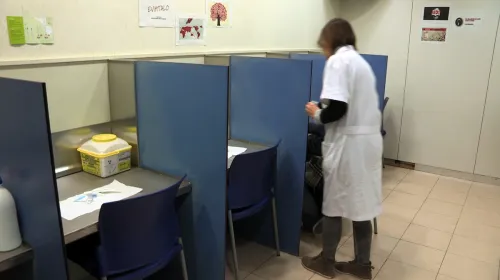Spotlight on… Drug consumption rooms

What are drug consumption rooms?
Drug consumption rooms, sometimes known as supervised injecting facilities, are fixed or mobile spaces in which people who inject drugs are provided with sterile injection equipment and can use illicit drugs under the supervision of trained staff. In some countries, consumption rooms also provide a space and equipment to allow non-injecting routes of administration, for example for crack cocaine smokers. Drug consumption rooms exist in several European countries and are usually located in areas where there is an open drug scene and injecting in public places is common. Their primary goal is to reduce morbidity and mortality by providing a safer environment for drug use and training clients in safer forms of drug use. Providing a conduit to other care services and reducing public nuisance may also be an explicit objective.
What problems do they address?
Drug consumption rooms were originally developed as a public health response to the rapid spread of HIV/AIDS among people who inject drugs in the 1980s. Their aims were to reduce the risks of unhygienic injecting, prevent fatal overdoses and the spread of infectious diseases, and link drug users with treatment, health and social services. More recently, in some countries, provision has also been provided for other routes of administration such as smoking or inhaling drugs. The establishment of drug consumption rooms has sometimes been opposed by local communities because of fears that they might aggravate open drug scenes. However, counterarguments have been made that these facilities may reduce the harms to communities associated with public drug injecting.
What services are typically provided?
- A safer environment for drug use.
- Provision of sterile injecting equipment.
- Intervention in overdoses that occur on-site.
- Counselling services.
- Primary medical care.
- Training for clients in safer forms of drug use, overdose awareness and the use of naloxone.
- Referral of clients to appropriate social, healthcare and treatment services.
- Some drug consumption rooms also promote engagement in opioid agonist treatment.
- Other frequently provided services include tea and coffee, use of a phone, and the possibility to take a shower and wash clothes.
Conditions and access
Access to consumption facilities may be restricted to registered service users, and often certain conditions have to be met, for example minimum age and local residency. Typically, drugs used in these facilities must be obtained prior to entry. Drug dealing and drug sharing are not allowed within the facilities (staff may be required to engage the police if necessary), and staff cannot assist clients in administering their drugs.
Operational models
Three operational models are typically used in Europe:
- integrated services, operating from separate areas attached to low-threshold facilities, where supervision of drug consumption is one of several services offered;
- specialised services, only offering the narrower range of services directly related to supervised consumption;
- mobile services, providing a geographically flexible deployment of the service, but typically catering for a more limited number of clients than fixed premises.
Drug consumption rooms are usually staffed by nurses and social workers, but doctors, security staff and peer workers may also be part of the team. Other professional groups may also be represented. Opening hours and the number of daily visits vary considerably across jurisdictions and between facilities.
Drug consumption rooms in Europe
Drug consumption rooms have been operating in Europe since 1986, when the first one was established in Bern, Switzerland. Since then, Norway and an increasing number of EU countries have opened facilities in one or more of their cities.

Looking to the future
As frontline, low-threshold services, drug consumption rooms are often among the first to gain insights into new drug use patterns and, thus, they have a role to play in the early identification of new and emerging trends among high-risk populations using their services.
As rates of injecting in some countries decrease, consideration has been given to using drug consumption rooms to reduce harms associated with other routes of administration (e.g. smoking) or other substances (e.g. cocaine and methamphetamine). This implies some changes in the aims of this response, and research and evaluation will be necessary to assess the effectiveness of this approach with non-injecting populations.
More generally, despite the difficulties of conducting research in this setting, more studies are needed to improve the evidence on the extent to which they reduce individual and community harms, both for outcomes associated with drug injecting and those associated with non-injecting routes of administration.








